Menus
- Can keep up with the oldie?
- Just don’t copy the Japanese
- Machines with over 200,000 kilometers are seen more often
- 1300 quad goes through as a brutal racing engine
- RS engine like a distinguished gentleman in a fine corduroy suit
- The potential of the BMW K 1300 S can only be exploited by very good drivers
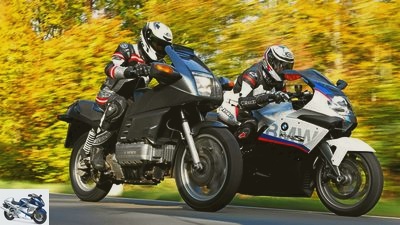

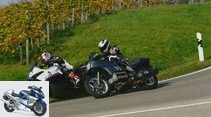
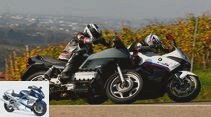
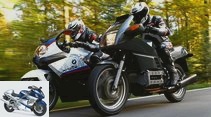
29 photos
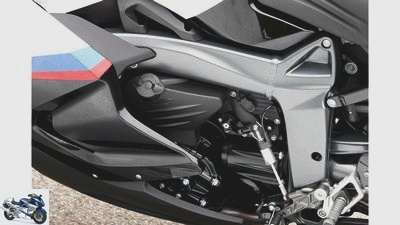
1/29
BMW K 1300 S..
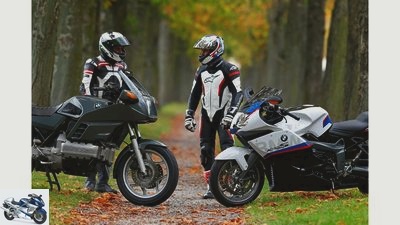
2/29
BMW K 100 RS and BMW K 1300 S..
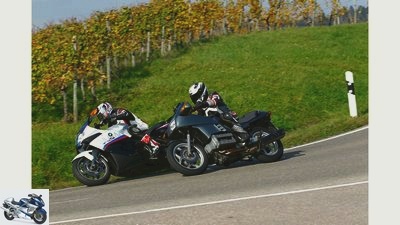
3/29
BMW K 100 RS and BMW K 1300 S..

4/29
BMW K 100 RS and BMW K 1300 S..
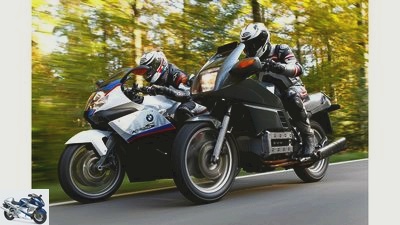
5/29
BMW K 100 RS and BMW K 1300 S..
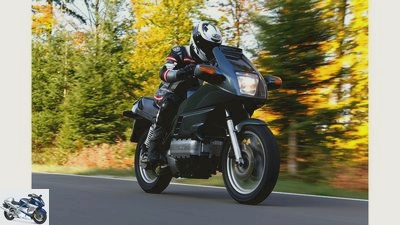
6/29
BMW K 100 RS.
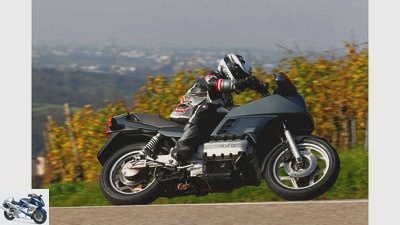
7/29
BMW K 100 RS.
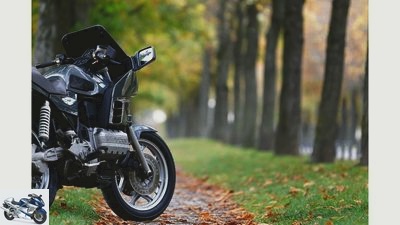
8/29
BMW K 100 RS.
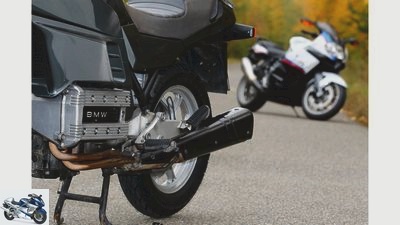
9/29
BMW K 100 RS.
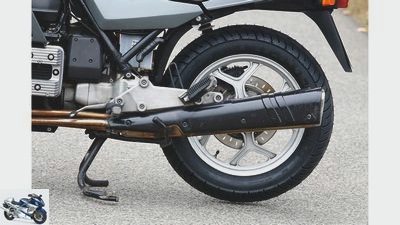
10/29
BMW K 100 RS.
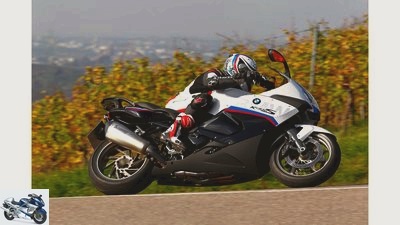
11/29
BMW K 1300 S..
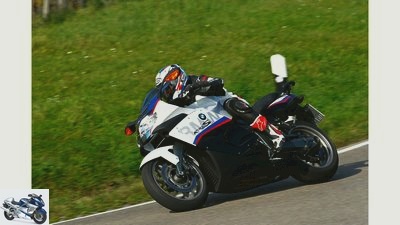
12/29
BMW K 1300 S..
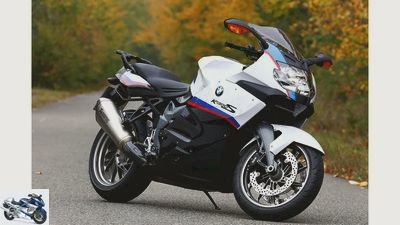
13/29
BMW K 1300 S..
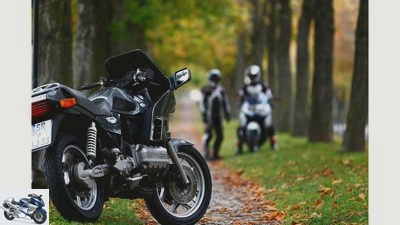
14/29
BMW K 100 RS and BMW K 1300 S..
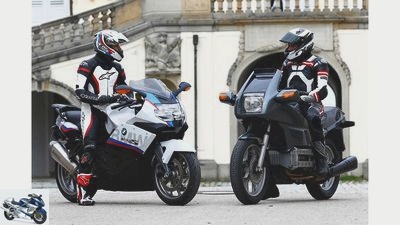
15/29
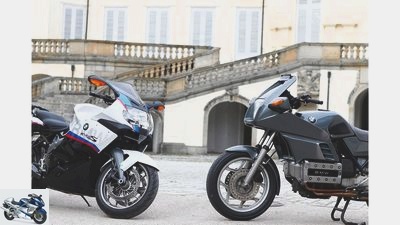
16/29
BMW K 100 RS and BMW K 1300 S..
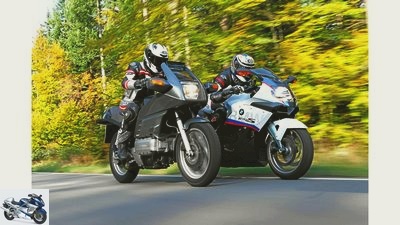
17/29
BMW K 100 RS and BMW K 1300 S..
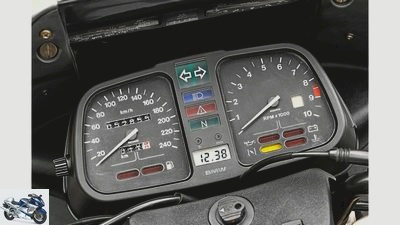
18/29
K 100 RS. What a cockpit: tired, high-revving hands, lights from the van construction, double spare lights. The red area threatens above 8300 rpm. The design of the cladding has remained to this day
unique, its effect unmatched …
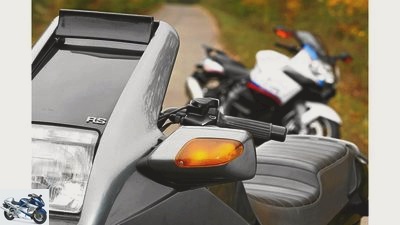
19/29
… Wind protection and noise comfort are fully up to date.
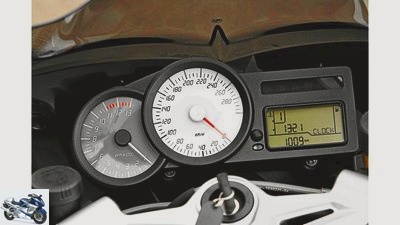
20/29
K 1300 S. A cockpit like that of a super sports car, not pretty, but functional. The tachometer now allows 11,000 rpm …
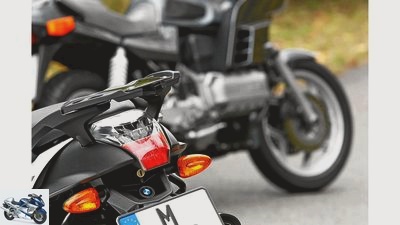
21/29
… The simplicity and uniqueness of the first K series gave way to an increasingly lush design language over the years. It feels like at least 100 more plastic parts per machine.
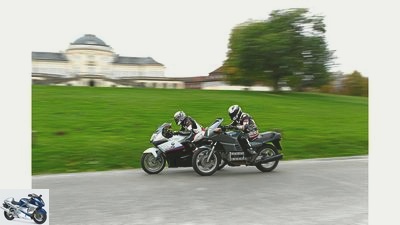
22/29
BMW K 100 RS and BMW K 1300 S..
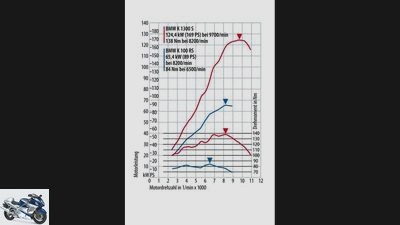
23/29
K 100 RS: My God, where is the performance? From 1000 cc, BMW got a meager 89 hp with a meager 84 Nm torque …
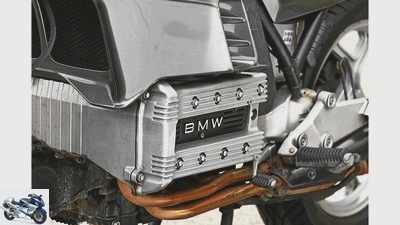
24/29
… At least the flying brick provided a harmonious curve. But the Japanese competition was much stronger back then.
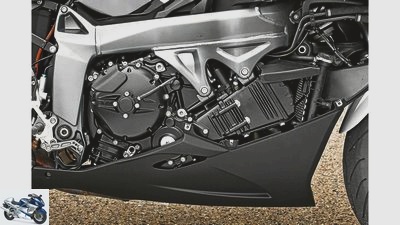
25/29
Also K-funny: almost lying four of the current series, at least now with a transverse crankshaft. But the power and torque are right. The 1300 is a great guy that almost nobody can hold a candle to. Hardly a Japanese either.
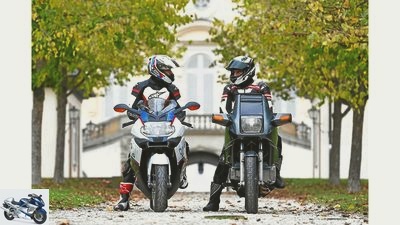
26/29
Conceptually, the special four-cylinder from BMW will soon be history.
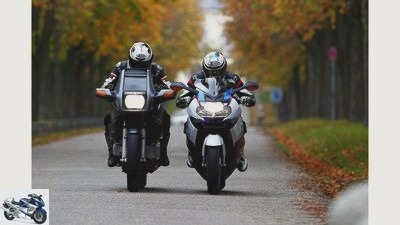
27/29
BMW K 100 RS and BMW K 1300 S..
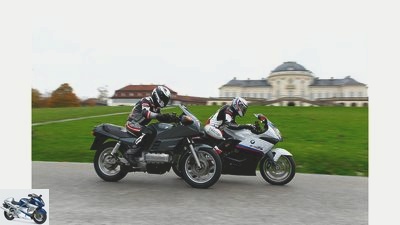
28/29
BMW K 100 RS and BMW K 1300 S..
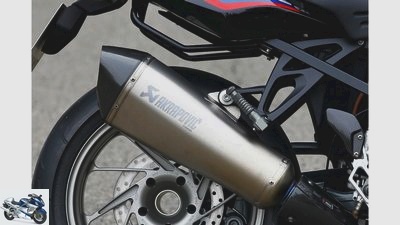
29/29
BMW K 1300 S..
Generation comparison of the BMW K 100 RS and BMW K 1300 S
Can keep up with the oldie?
If there are 30 years between two motorcycles, they are worlds apart. As with a BMW K 100 RS, the first BMW four-cylinder touring athlete, and a BMW K 1300 S, currently the last. But they’re both good.
It was 1984 when the BMW world was halfway in order again. The Munich had the BMW K 100 RS presented, a four-cylinder engine that was able to keep up to some extent with the Japanese superiority. A machine that, thanks to developments in the wind tunnel, was groundbreaking in terms of wind protection. Believing that a four-cylinder would also make sense in a motorcycle with a horizontal crankshaft. Which was a mistake. But we’ll get to that later. At the end of the K series, because it is no longer to be further developed, there is now the BMW K 1300 S..
Buy complete article
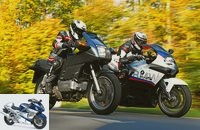
Generation comparison of the BMW K 100 RS and BMW K 1300 S
Can keep up with the oldie?
K 1300 S are different. Both in their own way. And that’s what makes them so likable. The small Bavarian village against the overwhelming power from the Far East. Asterix and Obelix against the Romans. Maybe a very good picture.
Just don’t copy the Japanese
Amazing: Even today, a BMW K 100 RS still looks somehow modern and independent. Of course, the muffler is still bad, too long, too square. But the rest is fine. The coarse engine block is nicely integrated in the machine, a simple frame holds the whole thing together, the seat bench end carries a small luggage rack like in convertibles from the 1960s. The slim cladding with the two characteristic blinking mirrors is hardly expected to have wind protection. The greater the surprise when you drive. Almost no wind pressure, hardly any turbulence, even today many drivers of touring athletes or even touring enduros would be happy to be able to eat kilometers of motorway in such a noiseless and protected manner.
The BMW developers at the beginning of the 1980s did just that well. Wind tunnel work, design based on the constructive requirement to put a clearly drawn motorcycle on its wheels. Marketing was responsible for the fact that the four-cylinder in-line had to lie and its crankshaft should even turn in the direction of travel. Just don’t copy the Japanese. The developers had a lot of trouble with that. When placed on the side stand, the cooling combustion chambers drew oil past the piston rings. Plumes of smoke on cold starts were a problem. Power and torque were difficult to get due to the small cylinder bore, but it was not allowed to grow so that the block would not be longer. After all, a dry clutch and a gearbox including cardan drive had to be flanged on. The 1000-series two-valve engine of the BMW K 100 RS generated an arduous 90 hp; The Japanese already had over 130 hp.
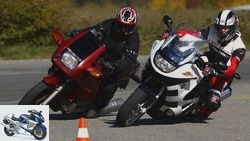
Tourer
20 years of the BMW K series: comparison of the K 100 RS against the K 1200 RS
The history of the K
read more
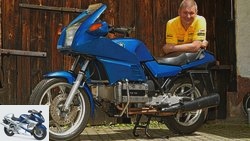
Sports & scene
Adventurous motorcycle transport of the BMW K 100 RS to the GDR
German-German friendship
read more
All articles about the BMW K 100 RS
Machines with over 200,000 kilometers are seen more often
Today, in times of a return to inner values and the farewell to the performance debate, there are many for whom 90 hp is enough. And the BMW K 100 RS serves them with raw charm. Singing with the primary drive as only she can, revving up tough thanks to the lush centrifugal mass, as only she could afford. But it pulls through the whole area stress-free, can be switched noise-free if you take some time. The narrow 18-inch tires and the high center of gravity make the RS a handling miracle. It tied through curves at lightning speed, also because the crankshaft rotates lengthways.
Of course, the cardan hardens the suspension when you accelerate, which the owner of our Test-K contained with a hard white power shock absorber. And, of course, the long-travel, soft fork brings restlessness to the chassis during hectic driving. But anyone who drives a BMW K 100 RS today knows these peculiarities. In time they will become flesh and blood anyway. You then take it a little more carefully here and there. Many a RS owner has several hundred thousand kilometers on the clock, which is also displayed thanks to the six-digit odometer. With good treatment, the 1000 runs forever. Machines with over 200,000 kilometers are seen more often. And you can see from the crew that they all drove the kilometers themselves. Great. It always moves me deeply.
1300 quad goes through as a brutal racing engine
What a great, great contrast is revealed when the BMW K 1300 S is visited. Except for the letter K, it has nothing to do with the BMW K 100 RS. Really absolutely nothing. Except that it is also constructed very differently from the ideal standard Japan machine. Now with an almost horizontal four-cylinder, which was installed transversely. And Megalever running gear, i.e. a Paralever swing arm for the cardan drive at the rear and a Duolever guide for the front wheel. Quite a laborious way of doing without a fork. You need a special shock absorber, two special ball joints, four more bearings for the trailing arms, a specially made wheel guide fork and much more. This is so complicated that no one will ever copy it. That much is clear.
While the engine of the BMW K 100 RS was still a good puller, the 1300 quad of the current BMW K 1300 S can pass as a brutal racing engine. What this great guy hits on the rear wheel inspires everyone respect. Almost without momentum, it bites, at any speed it feels twice as strong as the old Schlegel. At least. Horns, babbles and roars from the exhaust, what a spectacle. In no time at all, the clock is 200 km / h and only fourth gear is possible. You kicked it in with an automatic gearshift without a clutch. A sports tourer with a high-tech drive. For example, note the rocker arms for valve control. Expensive, and can only be found in the S 1000 and the brand new Yamaha R1.
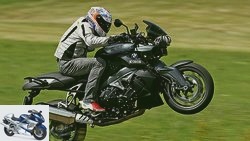
Used purchase
BMW K 1300 series
Buy used BMW K 1300 properly
read more

Tourer
Comparison test BMW K 1300 S, Kawasaki ZZR 1400, Suzuki Hayabusa 1300
Speed bikes in comparison
read more
All articles about the BMW K 1300 S
RS engine like a distinguished gentleman in a fine corduroy suit
While the old engine of the BMW K 100 RS still looked like a distinguished gentleman in a fine corduroy suit, the 1300s pulls the wide suspenders on his leather leather belts tight. And grins fat, because nothing can follow him. Not even the ambitious driver of a significantly enhanced sedan from southern Germany, you sniff something like that and let it shrink to the point in the rearview mirror. The brakes work hardest. The new one is anchored as if a brake rocket were ignited. Thanks to the elaborate front suspension, it also remains extremely stable. It is easy to dare to poke a nose at a GP driver with this BMW K 1300 S. Carbon brake discs should perhaps be used. So that Marc Márquez is shocked right away.
The old lady, on the other hand, only slows down gently, unwillingly stirs the fork, and you can’t even hope for an ABS system. It wasn’t ready for series production until four years later. Foresighted driving, conscious handling of your own speed, a trained eye for the road and traffic, simply everything that makes a good driver is needed for the BMW K 100 RS.
The potential of the BMW K 1300 S can only be exploited by very good drivers
And even more for the Bavarian bomb. Because despite all ABS, TCS, EDS and Haven’t You Seen Regulation, the potential of the BMW K 1300 S in today’s road traffic can only be exploited by a very good driver. But that is a fundamental problem that one has nowadays not only with all fast motorcycles, but also with most fast cars. They are so good that sometimes you don’t get enough of the point in the physics of driving that you have already reached. And above all, whether all the others also noticed.
For those who can do it, the BMW K 1300 S is still the first choice when it comes to quickly reaching another location in another country. Only helicopters are more flexible. The BMW K 100 RS could do that quite well 30 years ago. Yes, that was its big advantage compared to many other machines. The long-distance suitability, the cardan drive, the wind protection. Will the completely normal new four-cylinder, such as an S 1000 RX, also bring that? That is not impossible. But conceptually, the two special and so different four-cylinders from BMW will soon be history.
Related articles
-
Comparison test Kawasaki GTR 1000, Triumph Trophy 1200, Yamaha FJR 1300
fact comparison test Kawasaki GTR 1000, Triumph Trophy 1200, Yamaha FJR 1300 As time goes by In honor grayed out ?? and still to have: two veteran …
-
fact Concept comparison Honda CBR 1100 XX Kawasaki ZX-12 R Suzuki GSX-R 1000 Suzuki GSX 1400 Yamaha FZS 1000 Fazer Yamaha FJR 1300 Six bombs The six …
-
Generation comparison Suzuki 1200-1250 Bandit
Generation comparison Suzuki 1200/1250 Bandit Glorious bandits Suzuki’s extremely successful large Bandit models are the prelude to a new series in…
-
BMW K 1300 S HP and Honda VFR 1200 F DCT in comparison
fact 13 photos fact 1/13 Comparative test of big bikes: in the display of the sporty styled cockpit of the BMW K 1300 S HP, all imaginable information…
-
Generation comparison: Honda RVF 750, Fireblade, Yamaha YZF-R7, YZF-R1
fact Generation comparison: Honda and Yamaha Superbikes then and now in comparison Content of What can the noble homologation models of the Superbike…
-
Comparison test: Benelli TnT R 160, BMW K 1300 R, Ducati Streetfighter S
fact comparison test: Benelli TnT R 160, BMW K 1300 R, Ducati Streetfighter S The strongest and most extravagant naked bikes Life is too short to …
-
Cruiser comparison test: Honda VTX 1300 S, Kawasaki VN 1600 Classic
Cruiser comparison test: Honda VTX 1300 S, Kawasaki VN 1600 Classic Damn long and heavy Handy six-centimeter chunks, wheelbases begging for parking bay, …
-
BMW R nineT, Moto Guzzi Griso 1200, Yamaha XJR 1300 and Honda CB 1100 in comparison
www. 38 pictures www. 1/38 What an eerie attraction the BMW R nineT, Moto Guzzi Griso, Yamaha XJR 1300 and Honda CB 1100 …
-
Generation comparison Ducati 1299 Panigale R Final Edition 2017 and Ducati 1199 Panigale from 2012
markus-jahn.de 27 photos markus-jahn.de 1/27 Generation comparison: 1199 Panigale vs. 1299 Panigale R Final Edition. markus-jahn.de 2/27 Generation…
-
Generation comparison: Honda CBR 600 F
Rivas Generation comparison: Honda CBR 600 F The Honda Sportourer compared to its ancestors The new CBR 600 F has a difficult legacy. What does progress…